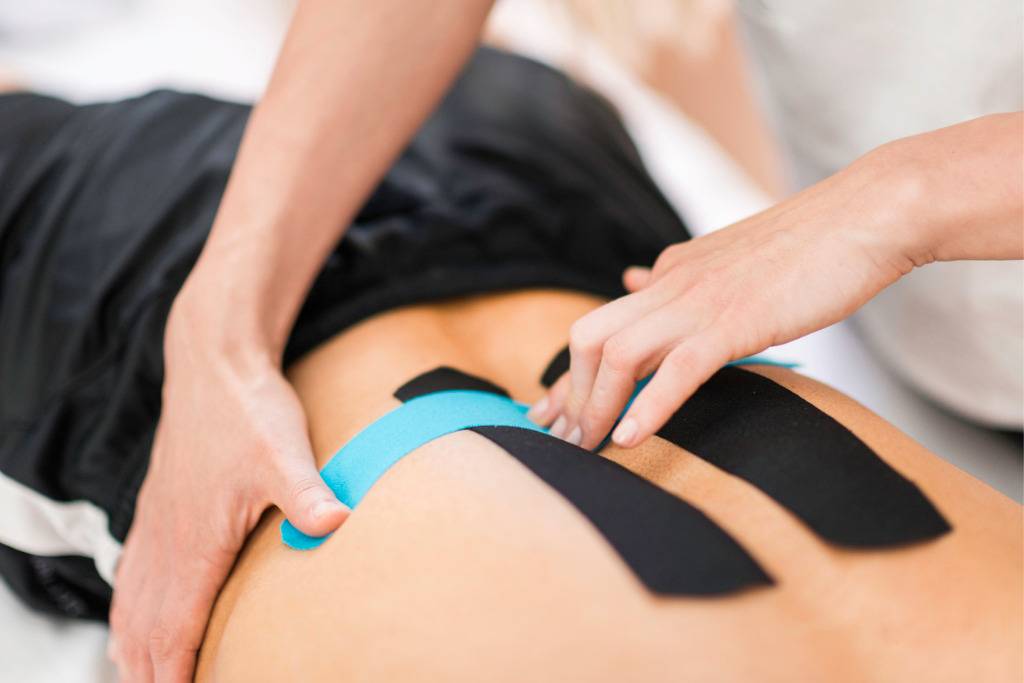Kinesiotaping is a popular therapeutic approach in the overlap between physical therapy, sports medicine, and chiropractic care. Flexible pieces of kinesiotape are placed strategically around the affected area in order to guide muscular movement, improve circulation, and relieve pain. The tape is both waterproof and durable; it can therefore be worn during intense physical exercise as well as during rest. Often, tape does not need to be replaced by a practitioner for several days.
Given the flexibility of its applications as well as its multidimensional benefits, kinesiotaping has shown particular promise for the adjustment of posture and alignment during motion, particularly when it comes to foot pronation. Indeed, several studies have suggested that kinesiotaping may be a promising treatment for excessive pronation.1,2,3 In order to verify these findings, a 2020 study by physical therapists Senem Guner and Serap Alsancak aimed to characterize the benefits of kinesiotaping as a therapeutic intervention for foot pronation.4 A total of twenty participants (split equally by gender) with a current diagnosis of foot pronation were included in the study.
In order to optimize kinesiotape efficacy, the authors projected a laser line onto each participant as they stood, barefoot, with one foot on a force plate, thus illuminating the joint load carrying line. A practitioner then applied kinesiotape in a corrective fashion. Assessment of the joint load carrying line was done prior to kinesiotape application, immediately after, and then at 24-48 hours following application. A ruler was placed at the level of the joint line tangentially to the patella and ankle joint in order to quantify deviation of the joint load carrying line.
Interestingly, Guner and Alsancak found that kinesiotape corrected neither the weight bearing nor the joint load carrying line in any significant way. While improvement was noted in lateral knee joint movement at the time of application of the kinesiotape, this change did not persist into the 24-48-hour mark. This finding suggests that kinesiotape may experience waning efficacy with continued wear, perhaps due to stretching and/or loosened adhesion, and that the tape should be reapplied more frequently to maximize effectiveness.
While these findings are somewhat contradictory to those of previous studies, it is important to note a few pertinent factors which may have contributed. Firstly, the authors’ sample size was small and not particularly diverse in age (average age 19.7 ± 1.2 years); there is therefore ample opportunity for future studies to both replicate and expand on these findings. Moreover, other pertinent values which were assessed in other similar studies – such as changes in peak plantar pressure – were not assessed by Guner and Alsancak. A more multidimensional study may have revealed a more nuanced effect.
The authors do note that kinesiotaping still may be useful for amplifying sensory input and reduction of perceived discomfort. Furthermore, short-term use of kinesiotape may also prove more effective when paired with orthotic footwear. However, the authors findings do indicate the need for continued research.
References
1. Franettovich, M. M., Murley, G. S., David, B. S., & Bird, A. R. (2012). A comparison of augmented low-Dye taping and ankle bracing on lower limb muscle activity during walking in adults with flat-arched foot posture. Journal of science and medicine in sport, 15(1), 8–13. https://doi.org/10.1016/j.jsams.2011.05.009
2. Franettovich, M., Chapman, A., & Vicenzino, B. (2008). Tape that increases medial longitudinal arch height also reduces leg muscle activity: a preliminary study. Medicine and science in sports and exercise, 40(4), 593–600. https://doi.org/10.1249/MSS.0b013e318162134f
3. Lange, B., Chipchase, L., & Evans, A. (2004). The effect of low-Dye taping on plantar pressures, during gait, in subjects with navicular drop exceeding 10 mm. The Journal of orthopaedic and sports physical therapy, 34(4), 201–209. https://doi.org/10.2519/jospt.2004.34.4.201
4. Guner, S., & Alsancak, S. (2020). Kinesiotaping Techniques to Alter Static Load in Patients With Foot Pronation. Journal of chiropractic medicine, 19(3), 175–180. https://doi.org/10.1016/j.jcm.2019.12.004
